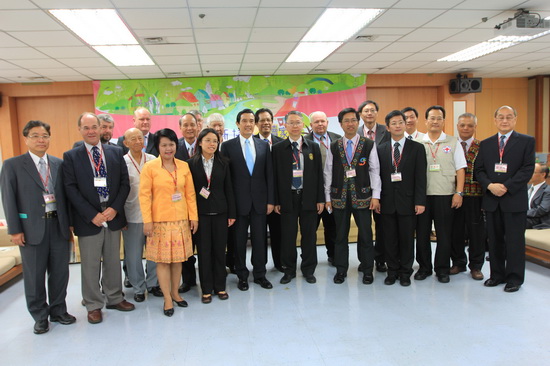


President Ma: Morakot reconstruction inspires new approaches to post-disaster recovery

A week prior to the second anniversary of the Typhoon Morakot disaster, the Morakot Post-Disaster Reconstruction Council of the Executive Yuan and the Kaohsiung-Pingtung Collegiate Alliance for the Reconstruction of the Morakot Typhoon-Affected Area today jointly held the International Conference on Post-Morakot Homeland Reconstruction with Sustainable Development at National Sun Yat-sen University in Kaohsiung.
The conference, titled “Rebuilding Sustainable Homeland with Innovation and United Efforts,” was attended by representatives from industry, government and academia from home and abroad as well as individuals from all sectors who have been concerned about the post-disaster reconstruction. Adding a global perspective to the event were 12 foreign guests from nine countries, including representatives from the Asia-Pacific Economic Cooperation forum, the European Union, the U.S. Agency for International Aid, as well as experts and scholars from Australia, New Zealand, Japan, Malaysia, Indonesia and Thailand. Before the conference, President Ma Ying-jeou met with the foreign visitors and representatives of domestic aid and construction organizations to express his thanks.
At the event, the president remarked that the devastation caused by Typhoon Morakot provided the nation with an opportunity for self-reflection. After the disaster, he said, the government has learned much from its experiences in each of the “1P3R” stages—referring to prevention, rescue, relocation and reconstruction.
During the prevention stage, Ma explained, the timeframe for enforcing evacuations should be brought forward, so that residents are cleared out in advance, not when the disaster is already happening. In terms of rescue, the government learned that small efforts can make a huge difference, as in the example of the Council of Agriculture’s prevention and rescue personnel stationed across the country, without whose help the death toll from Morakot might have been higher by as much as 1,000, according to estimates. Evacuation drills in high-risk areas should be conducted on a regular basis and a rescue network put in place so that people can be evacuated orderly before the disaster strikes, the president said.
As for relocation, Ma continued, the government has designated relocation sites and incorporated that information into evacuation exercises so that residents in high-risk areas know exactly where to go in an emergency.
Regarding reconstruction work, President Ma said the projects were carried out quickly and appropriately, and he credited the success to the swift passage of the Special Statute Governing Morakot Post-Disaster Reconstruction—completed only 20 days after the disaster. He said declaring an emergency decree was not critical at all for the situation as the existing Disaster Prevention and Protection Act already contains specific regulations for the needs at hand. The special statute, as it helps simplify related administrative procedures, was the key to fast and suitable execution of the reconstruction projects, he added.
President Ma further said that in reviewing the nation’s response in the two years since the disaster, it may be concluded that although prevention measures were insufficient and rescue resources strained, resettlement was completed quickly and reconstruction work able to meet the needs of the affected.
Prevention was insufficient because typhoons are common in Taiwan, so most people, being accustomed to them, are not always willing to evacuate right away. However, when the enormous storm actually struck and affected areas much larger than expected, it was not possible for the government to adequately attend to all the victims, thus putting severe strains on rescue resources. Therefore, the best approach is to take precaution and keep away from disaster, evacuating residents from high-risk areas before the disaster strikes, the president remarked.
“If the majority of the people have been relocated to safe places, then the relief work will be much easier to carry out. We can always recoup financial and property losses, but we can never bring back human lives,” he said.
The president stressed that after the disaster hit, the government immediately designated nearby military camps and veterans facilities as emergency shelters, an unprecedented measure that allowed for the prompt resettlement of displaced residents. As for reconstruction, private charity groups worked alongside government agencies. The government provided land and public facilities, while charity groups volunteered to construct permanent houses and basic facilities and revive local industries, said Ma.
“Borrowing from the private sector’s efficiency, innovation and long-term relationships with displaced residents, we were able to provide them with not only a house, but a home sweet home. We are also creating ‘colorful sustainable communities’ by meeting employment and schooling needs, offering cultural and spiritual support, and rebuilding communities. This will allow the communities to grow and create an exciting future for generations,” he said.
During the opening ceremony of the conference, President Ma, along with the Reconstruction Council’s CEO Lin Join-sane and Deputy CEO Chern Jenn-chuan, led special guests in lighting the “Light of Hope” sky lanterns, representing prayers for reconstruction area residents and for the future of Taiwan. The shining, ascending lanterns also signify that Morakot victims are gradually leaving their pains behind for a future filled with hope.
President Ma Meets Foreign Guests

President Ma and Guests Light Up Lights of Hope at the Conference

President Ma’s Speech at the Conference






